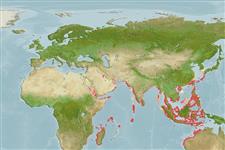Elasmobranchii (haaien en roggen) (sharks and rays) >
Carcharhiniformes (Ground sharks) >
Carcharhinidae (Requiem sharks)
Etymology: Scoliodon: scolio-, from skolios (Gr.), oblique; odon (Gr.), tooth, referring to oblique teeth pointing towards sides of mouth. (See ETYFish); laticaudus: latus (L.), wide or broad; cauda (L.), tail, allusion not explained, perhaps referring to width of upper caudal-fin lobe. (See ETYFish).
More on authors: Müller & Henle.
Environment: milieu / climate zone / depth range / distribution range
Ecologie
marien; brak water demersaal; amfidroom (Ref. 51243); diepte 10 - 13 m. Tropical; 26°C - 29°C (Ref. 4959); 34°N - 26°S, 32°E - 130°E
Indo-West Pacific: Persian Gulf (Ref. 68964), Somalia (Ref. 30573), Tanzania, Mozambique (Ref. 5213), Pakistan to Java in Indonesia; then Japan, China, and Taiwan. Reported from Australia (Ref. 4959).
Lengte bij maturiteit / Grootte / Gewicht / Leeftijd
Maturity: Lm 38.3, range 33 - 76.5 cm
Max length : 100.0 cm TL mannelijk / geslacht onbekend; (Ref. 5450); max. gerapporteerde leeftijd: 6 Jaren (Ref. 244)
Dorsale stekels (totaal): 0; Dorsale zachte stralen (totaal): 0; Anale stekels 0; Anale zachte stralen: 0. Bronze grey above, white below, fins sometimes darker than body; no conspicuous markings (Ref. 9997).
Found on rocky substrates of coastal waters and lower reaches of tropical rivers (Ref. 244). It is uncertain, however, if this species can live in perfectly fresh water for extended periods (Ref. 244). Forms large schools (Ref. 244). Adults feed on small bony fishes, shrimps and cuttlefish (Ref. 244). Viviparous (Ref. 50449). Common by-catch of the inshore demersal gillnet fisheries, particularly those operating off Kalimantan (Ref.58048). Utilized fresh for human consumption; processed into fishmeal and used as bait for other sharks and bony fishes (Ref. 244). Maximum sizes up to 120 cm unconfirmed (Ref. 244).
Viviparous, with an unusual columnar placenta (Ref. 244). Maternal and foetal placenta comprises the entire placenta (Ref. 39556). Transplacental nutrient transfer may be hemotrophic (Ref. 39556). Litter size varies from 1 (Ref. 58048) to 14 (Ref. 9997). Size at birth about 13 to 15 cm TL (Ref. 9997). Distinct pairing with embrace (Ref. 205).
Compagno, L.J.V., 1984. FAO Species Catalogue. Vol. 4. Sharks of the world. An annotated and illustrated catalogue of shark species known to date. Part 2 - Carcharhiniformes. FAO Fish. Synop. 125(4/2):251-655. Rome: FAO. (Ref. 244)
Status op de Rode Lijst van het IUCN (Ref. 130435)
Gebruik door de mens
Warning: mysqli::__construct(): (HY000/1040): Too many connections in /var/www/html/includes/func_getlabel.php on line 46
Can't connect to MySQL database (fbapp). Errorcode: Too many connections
